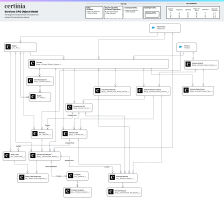Before you can use Services CPQ, you must:
- Assign Services CPQ licenses to your users.
- Install PSA Fall 2021 or later and assign PSA licenses to your users.
- Enable record locking and unlocking in Apex.
- Assign the relevant permissions to your users.
- Add the Estimates related list to the Opportunities record page layout.
- Set up an approval process.
- Set configuration options.
- [Optional] Customize Services CPQ Lightning components. For more information, see Services CPQ Lightning Components.
- [Optional] Enable the Estimate Path to use estimate stages.
- [Optional] Customize FinancialForce In-App Guidance.
For information about setting up the Services to Salesforce CPQ integration, see Setting up the Services to Salesforce CPQ Integration.
Data Model
This entity relationship diagram (ERD) illustrates the relationship between objects in Services CPQ, PSA, and Salesforce objects. FinancialForce's ERDs use crow foot's notation. For more information, see "About Entity Relationship Diagram Notation" in the Salesforce Help.
Click the image to open it in a new tab.
Permissions
You can assign the following permission set groups to users for access to Services CPQ:
| Permission Set Group Name |
Description |
|---|---|
| FF Group - SCPQ (CPQ Integration) - Estimator | Includes the CPQ - Push Estimate to Quote permission set. |
| FF Group - SCPQ - Estimate Approver | Includes the SCPQ - Approve Estimates permission set. |
| FF Group - SCPQ Estimator | Includes the following Services CPQ permission sets: Add Tasks from Template, Create Estimates, Create Projects from Estimates, Edit Estimates, Edit Price and Cost, and Submit Estimates. |
For more information about the permissions included in these permission set groups, see Permission Sets and Other Technical Documentation.
Salesforce Object Permissions Required for Permission Checks
Users assigned the permission sets listed in the table above will need Read access to Salesforce standard objects. For each permission set, the table below lists any fields that require field-level security access, and any additional access or permissions required.
| Permission Set Name |
Salesforce Object Permissions Required |
Fields Requiring Read FLS Access |
Notes |
|---|---|---|---|
| CPQ - Push Estimate to Quote | Opportunity | None | |
| SCPQ - Approve Estimates | Opportunity | None | |
| SCPQ - Create Estimate | Opportunity |
Account Name Group Practice Region |
Set up a permission control with the Resource Request Entry permission selected. |
| SCPQ - Create Projects from Estimates | None | None | |
| SCPQ - Edit Estimates | Opportunity | None | |
| SCPQ - Edit Price and Cost | Opportunity | None | |
| SCPQ - Submit Estimate | Opportunity | None |
For more information about permission set groups, see PSA Functional Permissions Overview.
Enabling Record Locking and Unlocking in Apex
Record locking and unlocking in Apex is required to ensure all related records are locked when an estimate is approved.
To enable this:
- From Setup, go to Process Automation | Process Automation Settings.
- Select the Enable record locking and unlocking in Apex checkbox, then click Save.
Configuring the Opportunities Record Page
To create and view estimates from the Opportunities record page, add the Estimates related list to the page layout. For more information, search for "Related Lists" in the Salesforce Help.
Setting up an Approval Process
To set up a basic approval process on the Estimate object:
- From Setup, click Create | Workflow & Approvals | Approval Processes.
- From the Manage Approval Processes For picklist, select Estimate.
- Click Create New Approval Process | Use Jump Start Wizard
- Enter a name for the approval process. For example, "Approve Estimates".
- Ensure the Add the Submit for Approval button and Approval History related list to all Estimate page layouts checkbox is selected.
- [Optional] Specify an entry criteria.
- Specify an approver.
- Click Save, then OK.
- Click View Approval Process Detail Page.
- In the Initial Submission Actions section, click Add New | Field Update.
- In the Name field, enter "Set Submitted Status".
- From the Field to Update picklist, select Approval Status.
- In the Specify New Field Value section, from the A specific value picklist, select Submitted.
- Click Save.
- Repeat steps 10-14 in the Final Approval Actions, Final Rejection Actions, and Recall Actions sections, using the following options from the A specific value picklist:
- Final Approval Actions: select Approved.
- Final Rejection Actions: select Rejected.
- Recall Actions: select Draft.
- On the approval process, click Activate.
For more information, see "Approvals" in the Salesforce Help.
Setting Configuration Options
Custom settings enable you to customize Services CPQ functionality and behavior. For more information, see Managing Custom Settings from Setup.
Enabling the Estimate Path
If you want to view and change the stage of an estimate, you must enable paths in your org.
- From Setup, go to User Interface | Path Settings.
- Click Enable.
Customizing FinancialForce In-App Guidance
FinancialForce In-App Guidance uses Salesforce user engagement features to deliver FinancialForce content, such as tutorials and learning paths, directly from our products.
Services CPQ includes a docked prompt, which displays a FinancialForce video tutorial overview of the app on the Services CPQ workspace. You can control the visibility of prompts, activate and deactivate them, and clone and customize them.
To find out more about FinancialForce In-App Guidance, see the FinancialForce In-App Guidance Quick Start Guide - Fall 2021.
To find out more about Salesforce User Engagement, see the Salesforce Help.
 SECTIONS
SECTIONS